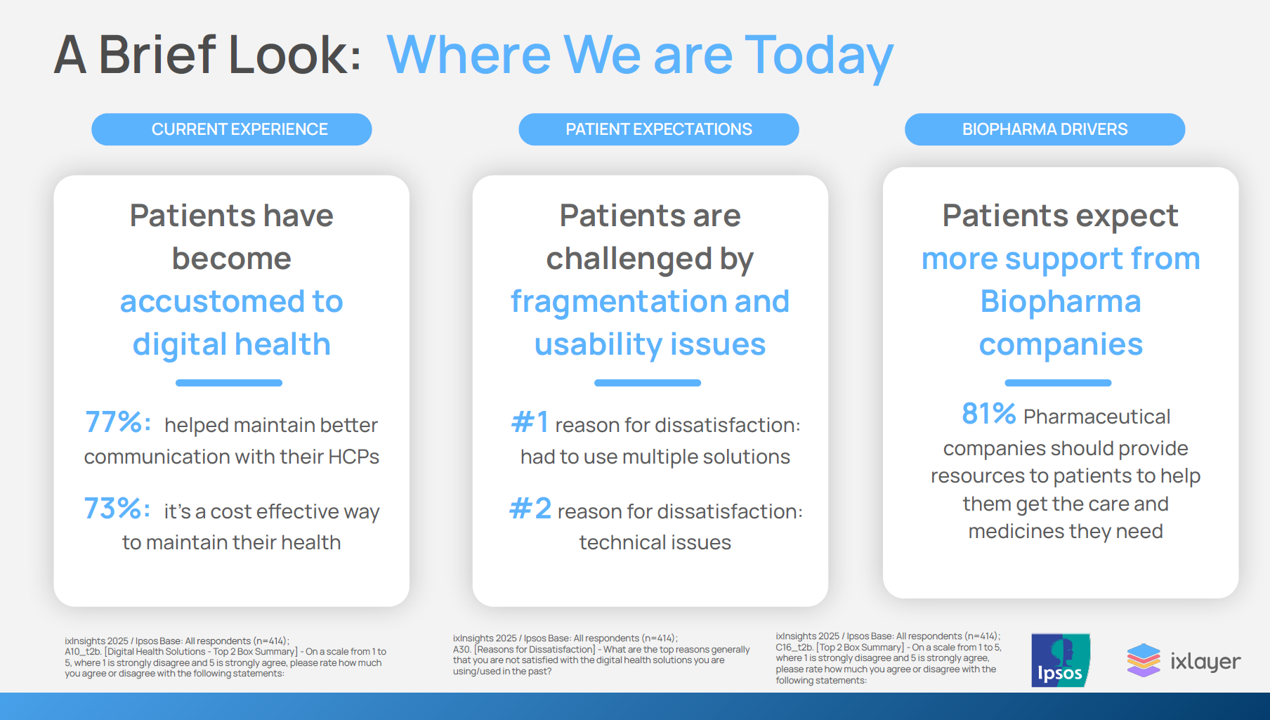Patients as health consumers now know what “good” looks like in their digital experiences. People have tasted the convenience and respect they feel from well-designed, streamlined omnichannel retail experiences, and they now expect this from health care — specifically supported by the pharmaceutical companies who manufacture the medicines they use in managing chronic conditions, we learn in ixlayer ixInsights 2025: Pharma’s Role in Improving the Health Experience from ixlayer and Ipaos.

The patient-focused report gets specific about people dealing with asthma, COPD, Type 2 diabetes, heart disease, psoriasis, and atopic dermatitis with a lens on what bio-pharmaceutical manufacturers (biopharma) can do to better support people in managing these conditions.
We note the first level which is at the base of people’s Maslow’s Hierarchy of Health/Care Needs: access to the medicines….and care. Four in 5 patients said that pharma companies should provide resources to help them get the care and medicines they need.
As Pouria Sanae, co-founder and CEO of ixlayer explained in the report’s press release, this patient viewpoint is an “expansion of DTC initiatives and services.”
And those services are underpinned and scaled through digital technology.

While most patients have had some experience using digital tools in their medicines-life-flows, one-half said they had to use more than one digital health platform, lacking a more integrated omnichannel approach. Typically, this would be a patient portal from a health care provider, and then the patient clicking into additional digital front doors such as telehealth platforms for virtual consults, pharmacy delivery channels, wearable tech app sites, and clinical lab websites.

ixlayer and Ipsos identified four key challenges addressing the UX/CX patient-centered views on dealing with biopharma for personal medical management; these covered,
- Communication
- Convenience
- Care support, and,
- Access barriers.
For this inaugural report, ixlayer and Ipsos surveyed 414 patients online in January 2025 who were dealing with asthma, COPD, Type 2 diabetes, heart disease, psoriasis, or atopic dermatitis.

Health Populi’s Hot Points: Patient engagement and activation can help bolster trust with the organizations who serve up well-designed and -intentioned digital tools. CVS Health’s recent research report into the critical role of consumer experience in health care quantifies the return on investing in UX and CX design for improving medication adherence.
As the report explains in the graphic, “improved patient experiences have an impact on increasing levels of trust in health care….Patients who adhere to a prescribed medication regimen not only experience reduced out-of-pocket costs, also are less likely to have to engage in high-cost clinical services like emergency department visits.”

That trust comes from the experience of convenience and access — as well as CVS Health’s call-out to “reduced out-of-pocket costs.” Patients’ financial experience is now embedded in the overall health care experience as the patient as health consumer is also a key payor in the financing of personal medical care. And even 40% of U.S. households earning over $180,000 a year are now worried about medical bills in America.





 I am so grateful to Tom Lawry for asking me to pen the foreword for his book, Health Care Nation,
I am so grateful to Tom Lawry for asking me to pen the foreword for his book, Health Care Nation,  Thanks to Feedspot for naming this blog, Health Populi, as a
Thanks to Feedspot for naming this blog, Health Populi, as a